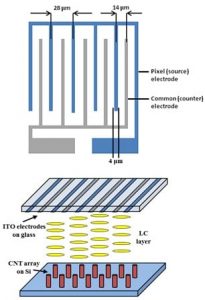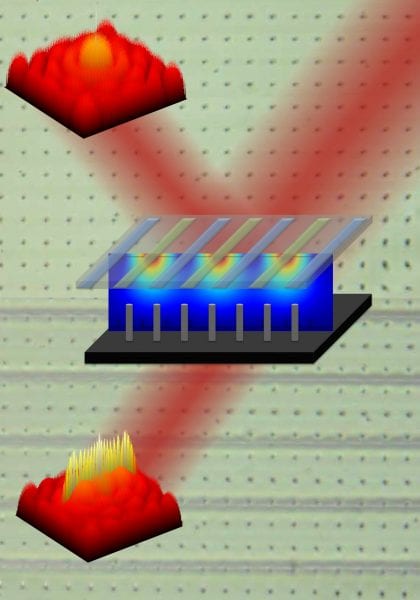 To increase the resolution of display devices, the pixel size must decrease. Pixel sizes are limited by the sizes of the electrodes used to create them. Taking a step toward addressing this problem, these authors collaborating across the UK, Australia and Sri Lanka have combined their knowledge of how to generate and manipulate nanoarchitectures with liquid crystal technologies, hybridising liquid crystals with carbon nanotubes to create an electrically switchable diffraction grating.
To increase the resolution of display devices, the pixel size must decrease. Pixel sizes are limited by the sizes of the electrodes used to create them. Taking a step toward addressing this problem, these authors collaborating across the UK, Australia and Sri Lanka have combined their knowledge of how to generate and manipulate nanoarchitectures with liquid crystal technologies, hybridising liquid crystals with carbon nanotubes to create an electrically switchable diffraction grating.
The hybrid device is composed of a liquid crystal (LC) layer sandwiched between two electrodes. The bottom electrode is a square, 2D array of carbon nanotubes (CNTs); the top electrode is an ITO-based in-plane switching (IPS) electrode on glass. When a voltage is applied, the IPS electrode causes a 1D array of lenses to be generated within the LC layer; however, the high-aspect-ratio CNTs produce defects within the LC layer, which generates a grid of distortions in the layer that cause it to behave as a 2D grating.
The pattern of this diffraction grating is voltage dependent, allowing the pattern and the device efficiency to be tuned simply by adjusting the voltage across the LC layer: when a laser is shone on the device, the light is diffracted by the grating pattern, altering the shape of the output light. This output is controlled by the input voltage.
Computational studies of the device agree well with the experimental findings, suggesting that this hybrid device can perform strongly predictable electrical switching. This sort of technology is expected to find application in optical communications, waveguides, and potentially 3D holographic displays.

















